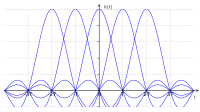
Photo from wikipedia
Abstract To achieve low latency and improved spectral efficiency, as well as satisfy massive connections, the application of non-orthogonal multiple access (NOMA) is a promising candidate in the physical layer… Click to show full abstract
Abstract To achieve low latency and improved spectral efficiency, as well as satisfy massive connections, the application of non-orthogonal multiple access (NOMA) is a promising candidate in the physical layer to consider in uplink and downlink in wireless network. In this paper, two user pairs are studied to exhibit performance gap since different power allocation factors provided. In particular, the Rayleigh fading channel models consisting of independent and non-identical (i.n.i.d.) and independent identically distributed (i.i.d.) are two considered cases to evaluate the outage probability of the proposed NOMA. Especially, practical environment is highlighted in scenario in which existence of co-channel interference (CCI) at both relay and destinations make their impacts on decreasing performance. In addition, successive interference cancellation (SIC) in two possible situations including perfect and imperfect SIC (pSIC, ipSIC) are further examined on system performance of such NOMA. To further provide clear performance evaluation, a closed-form expressions for the outage probability are derived and throughput performance is provided as well. This study also performs Monte Carlo simulations to validate the accuracy of the theoretical analysis. Furthermore, both the obtained analytical and simulation results demonstrate that the proposed NOMA scheme can offer performance gap between full-duplex (FD) mode and half-duplex (HD) mode implemented at the relay, and between pSIC and ipSIC as well.
Journal Title: Ad Hoc Networks
Year Published: 2020
Link to full text (if available)
Share on Social Media: Sign Up to like & get
recommendations!